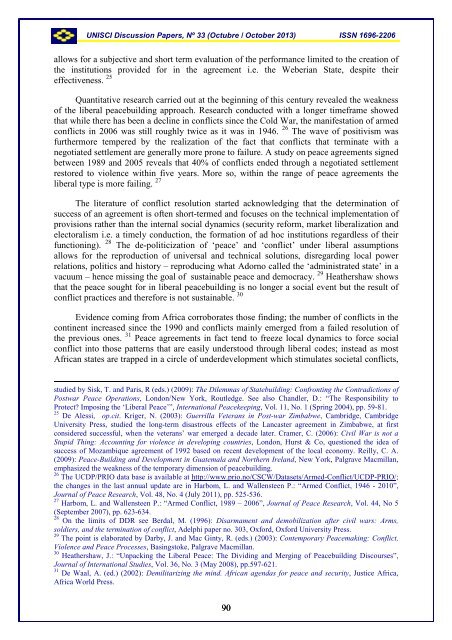UNISCI - Universidad Complutense de Madrid
UNISCI - Universidad Complutense de Madrid
UNISCI - Universidad Complutense de Madrid
Create successful ePaper yourself
Turn your PDF publications into a flip-book with our unique Google optimized e-Paper software.
<strong>UNISCI</strong> Discussion Papers, Nº 33 (Octubre / October 2013) ISSN 1696-2206allows for a subjective and short term evaluation of the performance limited to the creation ofthe institutions provi<strong>de</strong>d for in the agreement i.e. the Weberian State, <strong>de</strong>spite theireffectiveness. 25Quantitative research carried out at the beginning of this century revealed the weaknessof the liberal peacebuilding approach. Research conducted with a longer timeframe showedthat while there has been a <strong>de</strong>cline in conflicts since the Cold War, the manifestation of armedconflicts in 2006 was still roughly twice as it was in 1946. 26 The wave of positivism wasfurthermore tempered by the realization of the fact that conflicts that terminate with anegotiated settlement are generally more prone to failure. A study on peace agreements signedbetween 1989 and 2005 reveals that 40% of conflicts en<strong>de</strong>d through a negotiated settlementrestored to violence within five years. More so, within the range of peace agreements theliberal type is more failing. 27The literature of conflict resolution started acknowledging that the <strong>de</strong>termination ofsuccess of an agreement is often short-termed and focuses on the technical implementation ofprovisions rather than the internal social dynamics (security reform, market liberalization an<strong>de</strong>lectoralism i.e. a timely conduction, the formation of ad hoc institutions regardless of theirfunctioning). 28 The <strong>de</strong>-politicization of ‘peace’ and ‘conflict’ un<strong>de</strong>r liberal assumptionsallows for the reproduction of universal and technical solutions, disregarding local powerrelations, politics and history – reproducing what Adorno called the ‘administrated state’ in avacuum – hence missing the goal of sustainable peace and <strong>de</strong>mocracy. 29 Heathershaw showsthat the peace sought for in liberal peacebuilding is no longer a social event but the result ofconflict practices and therefore is not sustainable. 30Evi<strong>de</strong>nce coming from Africa corroborates those finding; the number of conflicts in thecontinent increased since the 1990 and conflicts mainly emerged from a failed resolution ofthe previous ones. 31 Peace agreements in fact tend to freeze local dynamics to force socialconflict into those patterns that are easily un<strong>de</strong>rstood through liberal co<strong>de</strong>s; instead as mostAfrican states are trapped in a circle of un<strong>de</strong>r<strong>de</strong>velopment which stimulates societal conflicts,studied by Sisk, T. and Paris, R (eds.) (2009): The Dilemmas of Statebuilding: Confronting the Contradictions ofPostwar Peace Operations, London/New York, Routledge. See also Chandler, D.: “The Responsibility toProtect? Imposing the ‘Liberal Peace’”, International Peacekeeping, Vol. 11, No. 1 (Spring 2004), pp. 59-81.25 De Alessi, op.cit. Kriger, N. (2003): Guerrilla Veterans in Post-war Zimbabwe, Cambridge, CambridgeUniversity Press, studied the long-term disastrous effects of the Lancaster agreement in Zimbabwe, at firstconsi<strong>de</strong>red successful, when the veterans’ war emerged a <strong>de</strong>ca<strong>de</strong> later. Cramer, C. (2006): Civil War is not aStupid Thing: Accounting for violence in <strong>de</strong>veloping countries, London, Hurst & Co, questioned the i<strong>de</strong>a ofsuccess of Mozambique agreement of 1992 based on recent <strong>de</strong>velopment of the local economy. Reilly, C. A.(2009): Peace-Building and Development in Guatemala and Northern Ireland, New York, Palgrave Macmillan,emphasized the weakness of the temporary dimension of peacebuilding.26 The UCDP/PRIO data base is available at http://www.prio.no/CSCW/Datasets/Armed-Conflict/UCDP-PRIO/;the changes in the last annual update are in Harbom, L. and Wallensteen P.: “Armed Conflict, 1946 - 2010”,Journal of Peace Research, Vol. 48, No. 4 (July 2011), pp. 525-536.27 Harbom, L. and Wallensteen P.: “Armed Conflict, 1989 – 2006”, Journal of Peace Research, Vol. 44, No 5(September 2007), pp. 623-634.28 On the limits of DDR see Berdal, M. (1996): Disarmament and <strong>de</strong>mobilization after civil wars: Arms,soldiers, and the termination of conflict, A<strong>de</strong>lphi paper no. 303, Oxford, Oxford University Press.29 The point is elaborated by Darby, J. and Mac Ginty, R. (eds.) (2003): Contemporary Peacemaking: Conflict,Violence and Peace Processes, Basingstoke, Palgrave Macmillan.30 Heathershaw, J.: “Unpacking the Liberal Peace: The Dividing and Merging of Peacebuilding Discourses”,Journal of International Studies, Vol. 36, No. 3 (May 2008), pp.597-621.31 De Waal, A. (ed.) (2002): Demilitarizing the mind. African agendas for peace and security, Justice Africa,Africa World Press.90
















